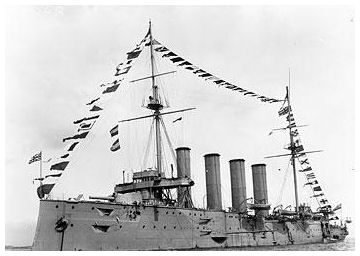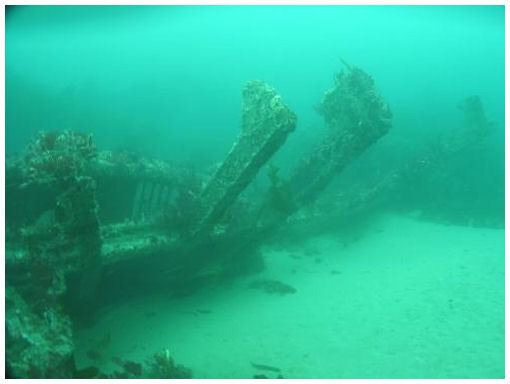
HMS Drake
HMS Drake was an armoured cruiser of the Royal Navy the first of a class of four.
Armoured cruisers were cruisers that incorporated armour on the sides as well as on the deck and coal bunkers to counter the threat from explosive shells that were developed in the mid 19th century.
Construction of the Drake began in 1899, it was launched in 1901 and was commissioned in March 1905.
She displaced 14,000 tonnes and could travel at up to 23 knots per hour, one of the fastest cruisers at the time.
Construction Problems
Its first captain was John Jellicoe who later became commander of the Royal Navy. He became famous as the commander of the Royal Navy forces that took part in the battle of Jutland, World War I’s largest naval engagement and the last sea battle between battleships.
Jellicoe’s letters to his superintendent while captain of the Drake reveal that the Drake had some serious construction faults.
In Action
Once commissioned it traveled extensively and took part in ceremonial duties hosting among others the queens of Spain, Portugal and Greece. By 1913 she was considered almost obsolete and placed on reserve.
With the outbreak of World War I the Drake was put onto active duty again and given the role of escort. Among the ships she escorted was the Olympic sister ship of the Titanic.
Torpedoed!
On April 2, 1917 the HMS Drake, under the command of Captain Radcliffe, had just completed a mission of escorting convoy HH24 that was coming from America.
At around 9:00 in the morning she was torpedoed by the German U-Boat U79 which had been laying mines in the vicinity of Rathlin Island. The torpedo hit the second boiler room which flooded immediately and killed everyone in it except two lucky sailors. One was thrown by the explosion onto the upper deck unhurt and the other managed to climb away.
To Church Bay
The ship was still capable of sailing though the torpedo attack had damaged the steering gear. Radcliffe hoped to sail her to Belfast Lough for repairs but realizing that his was not possible decided to sail to nearby Church Bay by Rathlin Island .
On her way there she collided with the cargo ship Mendip Range. The Mendip Range was badly damaged and run aground near Ballycastle, but the Drake managed to limb to Church Bay.
Capsized
Radcliffe was hoping to save her by landing her on the beach. However, the degree of listing was became critical and she had to be abandoned. Everybody who survived the initial attack was ferried safely to land.
She capsized a few hundred meters from shore in a depth of about 18 meters. The total deaths from the attack was 19.
Other Losses
On the same day two other ships were lost. The merchant ship Lugano and the destroyer HMS Brisk. Initially reports suggested that both were sunk by torpedoes from U79 making an impressive tally for the U-Boat of a cruiser, a destroyer and a merchant ship sunk within the space of a few hours. Naval historians, however, now believe that these two ships were sunk after hitting mines placed by the U79.
The Story is not Over Yet
In 1962 the trawler Ella Hewett, on her way to Rathlin to leave a crewman who had taken ill, hit the remains of the Drake and sunk, fortunately with no loss of life.
In the 1970’s both the Drake and the Ella Hewett were ringed with charges and exploded to prevent further shipwrecks. In 1978 it was decided that too much fuel was leaking out from the vessels and another operation to clear this was launched.

A Most Popular Diving Site
The HMS Drake is nowadays one of the most popular diving sites. A number of factors contribute to this. First, it is in relatively shallow waters (18 meters). Second, the waters are relatively clear. If you like diving, this wreck is worth exploring.
Since 2006 Wessex Archaeology has been conducting studies of the wreck. If you are interested in archaeology, this is a website worthy exploring further.
The rugged coastline of North Antrim has been the place for more casualties. Have you read the story of The Exmouth and the The Girona shipwreck?
Photo credits: Photo no.1, public domain. Photo no. 2 Courtesy of Wessex Archaeology

